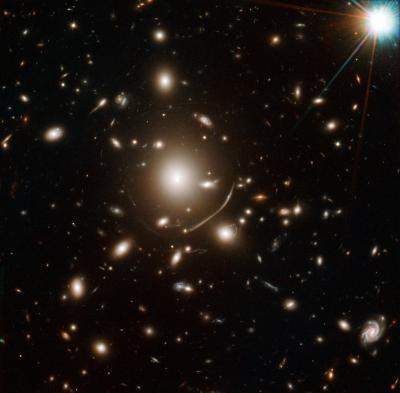Using the amplifying power of a cosmic gravitational lens, astronomers have discovered a distant galaxy whose stars were born unexpectedly early in cosmic history. This result sheds new light on the formation of the first galaxies, as well as on the early evolution of the Universe.
Johan Richard, the lead author of a new study [1] says: "We have discovered a distant galaxy that began forming stars just 200 million years after the Big Bang. This challenges theories of how soon galaxies formed and evolved in the first years of the Universe. It could even help solve the mystery of how the hydrogen fog that filled the early Universe was cleared."
Richard's team spotted the galaxy in recent observations from the NASA/ESA Hubble Space Telescope, verified it with observations from the NASA Spitzer Space Telescope and measured its distance using W. M. Keck Observatory in Hawaii.
The distant galaxy is visible through a cluster of galaxies called Abell 383, whose powerful gravity bends the rays of light almost like a magnifying glass [2]. The chance alignment of the galaxy, the cluster and the Earth amplifies the light reaching us from this distant galaxy, allowing the astronomers to make detailed observations. Without this gravitational lens, the galaxy would have been too faint to be observed even with today's largest telescopes.
After spotting the galaxy in Hubble and Spitzer images, the team carried out spectroscopic observations with the Keck-II telescope in Hawaii. Spectroscopy is the technique of breaking up light into its component colours. By analysing these spectra, the team was able to make detailed measurements of its redshift [3] and infer information about the properties of its component stars.
The galaxy's redshift is 6.027, which means we see it as it was when the Universe was around 950 million years old [4]. This does not make it the most remote galaxy ever detected — several have been confirmed at redshifts of more than 8, and one has an estimated redshift of around 10 (heic1103), placing it 400 million years earlier. However the newly discovered galaxy has dramatically different features from other distant galaxies that have been observed, which generally shine brightly with only young stars.

The giant cluster of elliptical galaxies in the centre of this image contains so much dark matter mass that its gravity bends light. This means that for very distant galaxies in the background, the clusters gravitational field acts as a sort of magnifying glass, bending and concentrating the distant objects light towards Hubble. These gravitational lenses are one tool astronomers can use to extend Hubbles vision beyond what it would normally be capable of observing.
Using Abell 383, a team of astronomers have identified and studied a galaxy so far away we see it as it was less than a billion years after the Big Bang. Viewing this galaxy through the gravitational lens meant that the scientists were able to discern many intriguing features that would otherwise have remained hidden, including that its stars were unexpectedly old for a galaxy this close in time to the beginning of the Universe. This has profound implications for our understanding of how and when the first galaxies formed, and how the diffuse fog of neutral hydrogen that filled the early Universe was cleared.
(Photo Credit: NASA, ESA, J. Richard (CRAL) and J.-P. Kneib (LAM). Acknowledgement: Marc Postman (STScI))
"When we looked at the spectra, two things were clear," explains co-author Eiichi Egami. "The redshift placed it very early in cosmic history, as we expected. But the Spitzer infrared detection also indicated that the galaxy was made up of surprisingly old and relatively faint stars. This told us that the galaxy was made up of stars already nearly 750 million years old — pushing back the epoch of its formation to about 200 million years after the Big Bang, much further than we had expected."
Co-author Dan Stark continues: "Thanks to the amplification of the galaxy's light by the gravitational lens, we have some excellent quality data. Our work confirms some earlier observations that had hinted at the presence of old stars in early galaxies. This suggests that the first galaxies have been around for a lot longer than previously thought."
The discovery has implications beyond the question of when galaxies first formed, and may help explain how the Universe became transparent to ultraviolet light in the first billion years after the Big Bang. In the early years of the cosmos, a diffuse fog of neutral hydrogen gas blocked ultraviolet light in the Universe. Some source of radiation must therefore have progressively ionised the diffuse gas, clearing the fog to make it transparent to ultraviolet rays as it is today — a process known as reionisation.
Astronomers believe that the radiation that powered this reionisation must have come from galaxies. But so far, nowhere near enough of them have been found to provide the necessary radiation. This discovery may help solve this enigma.
"It seems probable that there are in fact far more galaxies out there in the early Universe than we previously estimated — it's just that many galaxies are older and fainter, like the one we have just discovered," says co-author Jean-Paul Kneib. "If this unseen army of faint, elderly galaxies is indeed out there, they could provide the missing radiation that made the Universe transparent to ultraviolet light."
As of today, we can only discover these galaxies by observing through massive clusters that act as cosmic telescopes. In coming years, the NASA/ESA/CSA James Webb Space Telescope, scheduled for launch later this decade, will specialise in high resolution observations of distant, highly redshifted objects. It will therefore be in an ideal position to solve this mystery once and for all.
Source: ESA/Hubble Information Centre